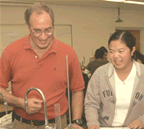The goal was to develop hands-on, non-lecture based courses for future elementary school teachers in physical science (physics and chemistry), biology and geology
January 29, 2007
By Debra Cano Ramos
Fifth-grade teacher Vanessa Dionne credits the experiences she gained from the 102-level science courses she took at Cal State Fullerton for helping her become a better science teacher.
“The courses provided me with the content and pedagogy to effectively teach science,” said Dionne, who graduated from CSUF with a B.A. in liberal studies and received a teaching credential in 2004.
“I enjoyed the classes because of the hands-on activities that I believe helped me to understand the content better,” Dionne said.
Dionne teaches general education and physical science at an intermediate school in the Montebello Unified School District. She hopes to eventually teach the 102 courses that inspired her.
As the creator of the courses for non-science majors, especially future elementary school teachers, physics professor Roger Nanes couldn’t be more thrilled with his former student’s ambitions.
“You can’t get a more positive outcome than that,” Nanes said of his curriculum development efforts.
Nanes is passionate about the science he teaches and how it is taught to children. Kids are fascinated by the world around them, he said, but not often motivated by teachers to study science in high school or college because they do not always understand basic science concepts.
“They are often intimidated and they generally feel that science is beyond them,” Nanes said.
As a result, he said, students may not become actively engaged in learning science or pursuing careers in scientific fields.
In 1997, Nanes was awarded a nearly $200,000 grant from the National Science Foundation to create “ConCEPT” (Contextual Coursework for Elementary Pre-Service Teachers). The goal of the project was to develop hands-on, non-lecture based courses for future elementary school teachers in physical science (physics and chemistry), biology and geology.
Nanes wrote the course materials for the physical science courses and, in 2003, his three-volume book, “Inquiry Into Physical Science: A Contextual Approach,” for future elementary school teachers was published.
Nanes began teaching Physics/Chemistry 102 in the spring of 1999. Biology 102 and Geology 102 followed in 2000.
One of the units in the physics/chemistry course focuses on global warming and only the science concepts necessary to understand the context, such as heat, temperature and light, are introduced. This contrasts with the more common approach in science courses for non-science majors, which covers a large number of seemingly unrelated concepts that appear to students to be merely a collection of facts, Nanes said.
Nanes now is working on writing an instructor’s guide for the 102 courses that area community colleges have already begun offering to future teachers.


